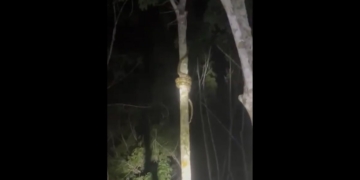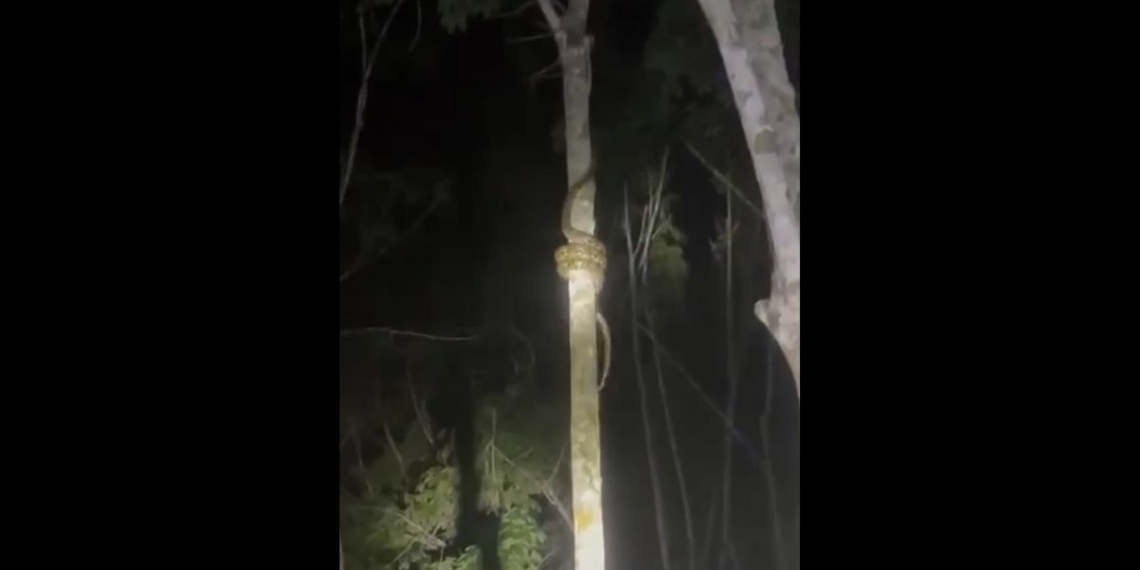Captivating — yet creepy — videos that recently resurfaced have gone viral, spotlighting arboreal snakes’ acrobatic capabilities while simultaneously reminding audiences everywhere about their ability to navigate trees vertically.
Viewer discretion is advised as this is the stuff of nightmares for those who suffer from Ophidiophobia.
In other words, if you already have a fear of serpents this is guaranteed to make it much worse.
This ability by these tree dwelling snakes, while widely known and established, has garnered fresh attention, illustrating a primal skill that seems almost as old as the story of Adam and Eve in the Garden of Eden.
Videos have resurfaced online showing what appears to be a reticulated python — which is semi-arboreal — climbing up a tree trunk.
Climbing skills of the reticulated python
Reticulated pythons are known for their remarkable climbing abilities. Despite being one of the world’s heaviest snakes, they can ascend trees with ease thanks to their prehensile tails, strong muscles, and sharp scales.
They use a… pic.twitter.com/i2gtDT2n3F
— Tree of Knowledge (@ToK_ScienceTree) March 23, 2024
The serpent can be seen advancing at a rapid speed.
How snakes climb trees pic.twitter.com/jYktwAy3gP
— Interesting Things (@interesting_aIl) May 9, 2024
“So large snakes do also climb trees! Am so shocked how this snake did it too fast,” wrote one X user, who posted a video of the spectacle.
So large snakes 🐍 do also climb trees! Am so shocked 😯 how this snake did it too fast. 🤔 pic.twitter.com/kbFwhptFRQ
— Lawrence Kitema (@lawrencekitema) May 3, 2024
A 2014 study published in Biology Letters and which appeared in National Geographic, led by herpetologist Greg Byrnes of Siena College and and his colleague Bruce Jayne from the University of Cincinnati, sheds light on the mechanics behind this fascinating behavior.
According to the study, when snakes climb trees, their strategy is less about finesse and more about brute strength.
Unlike other animals that may use physical appendages or special adaptations for climbing, snakes must rely solely on their muscular bodies.
They over-grip the tree, exerting a force much greater than what is needed merely to prevent sliding back down.
This method offers snakes a safety net against the risk of falling, which, while not typically fatal, could leave them vulnerable to predators below.
“A ten-meter fall is unlikely to really hurt a snake, but being back on the ground could expose them to predators. Then the snake will have to climb the tree again, and it might be more energy efficient to be more careful the first time,” Byrnes wrote.
And while the image of an arboreal snake tightly coiling its way up a tree might amplify a pre-existing phobia of them, this behavior underscores a crucial survival technique.
Climbing not only enables snakes to escape ground-level threats but also positions them to better hunt prey, fulfilling a critical role in their ecological niche.
Ultimately, as these viral videos of arboreal snakes ascending with spine-chilling precision proliferate again, it’s a stark reminder to everyone the captivating and terrifying beauty of nature.
This article appeared originally on The Western Journal.
















 Continue with Google
Continue with Google